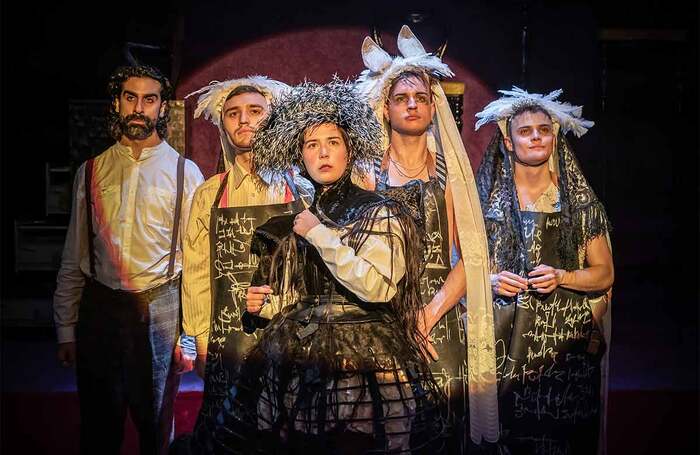The Yard
As a card-carrying whoopsie, Soho resident, and culture writer for the paper you are perusing, The Yard’s most recent play seems to tick my every box. The Flea Circus is in town, exploring a scandal that rocked Victorian London. Gays, promiscuity, and central London? Clearly, some things never change.
The Profumo and Thorpe affair, the trial of Oscar Wilde, and this particular spot of vintage naughtiness on Cleveland Street: Us Brits do love juicy romps between the haves and the have-nots. Politician or aristocrat, along as those in power are doing what they’re not supposed to, class and sex have repeatedly fired the indignation of the public. Of course, in the 19th century, there was much more at stake for those at the centre of these queer scandals than just shame. Imprisonment, hard labour, and literal exile. Happening only 10 years before the infamous disgrace of the playwright Oscar Wilde, this cover-up of the gay molly house (brothel) signals one of the last examples of the upper classes’ ability to hush up a raucous. Although recent royal news might beg to differ.
But I waffle, British queer history is a topic close to my heart. The tale has all you need for a good orgy of infamy, postboys moonlighting as gigolos, a seedy Fitzrovia setting, and illustrious upper-crust clients including (but never proved) a prince. But how do you stage Victorian London, replete with bent-coppers, poshos, and teenage prostitutes in the Yard’s versatile but petite space? Well, Jay Miller (director) and Naomi Kyuck-Cohen (set designer) roll up their ruffled sleeves and refuse to think within the box, quite literally. Purple felted walls, two raised semi-circles, walkways between them, and a stage spanning the back are the more expected set pieces. Then there’s the flashes of oddness. Floating tables and chairs protruding out of walls like Dali paintings, plinths, miniature furniture, and latex tablecloths warn us that this is not a stuffy period drama. After all, how could it be?
This out-of-the-box thinking marches unhampered throughout the piece, sometimes uplifting, sometimes tramping. Lambdog1066’s (amateur couture designer) costumes are if Adam Ant tried to redesign Vivienne Westwood’s 1974 SEX line, in the dark. Initially impressive as the 5 strong cast bounce on stage, oversized shoulder pads and limbs waggling, horsehair bursting out of pockets and stylised wigs askew. Very much like a fashion show, when merely strutting about being admired. But for an almost 2-hour long piece these stark splashes of colour and texture dizzy us away from the characters in question.
Even more ambitiously the makeup ignores the one rule of any theatre or Halloween costume, Glitter never leaves. The postboys have slashes of the stuff under their eyes, stylised yes, practical, no. Poor Connor Finch plays Henry, but also the tweeded (very unglittering) Lord Somerset, having to quick change a couple of times throughout the piece. The battle with the microplastic thus gives his face the hue of beetroot from all the scrubbing backstage and the shine of a Greek god. Enhance not overshadow.
But for all the moments that don’t quite work, there are as many that utterly do. In the tale of deprivation and inherited privilege, Norah Lopez Holden is our knock-off Nancy, mother of the lead postal boy Charlie Swinscow. Also and triumphantly, she is Queen Victoria protecting her wayward family from scandal. In a feathered hat and sex-club-like whalebone corset and crinoline, she has a conversation with god on stage, and a breakdown to TV/film depiction of her own rule (Young Victoria etc..), a divinely silly, and utterly thrilling comic take on a much-maligned monarch.
Throughout the acting is strong and muti-rolling effective, when not rubbing glitter out of their eyes that is. Sémus Mclean Ross as both the blustering, Bertie prince of Wales, and the soft lead Charlie Swinscome, pivots from blundering royal to vulnerable urchin with such skill I had to check the cast list to see if it was the same person. As mentioned, Finch as the naive aristocratic Somerset and the sexually confident yet childishly hopeful Henry Newlove has two wonderful performances to leap between. These three hold us in their palms, battling the busy surroundings to astound us again and again.
The piece thrives when James Fritz’s writhing writing is given the full space to flourish. Something sadly the limited space cannot always provide. The domestic scenes are by far the best. The prince of Wales and his mother battling over tea, her on a plinth, him looking up from one of the floating chairs, hit by a circular spot, artistic and sidesplitting. On the other hand, any scene that requires much movement literally and metaphorically stubs its toes on the many angles and corners of the overly full set. The temptation to play for comedy means that moments of gravity are rather lost. Interrogation scenes and emotional reunions fall under the clatters of unsure laughter from the audience.
Miller’s direction is trying so very hard. Surrealism, comedy, heartbreak, illusion, symbolism, class, and sexuality are bubbling in a play that keeps on pulling rabbits out of the hat. It’s an epic undertaking that is bursting through the seams of The Yard’s theatrical space. But should we aim for the clouds? I can’t always answer that question, but The Flea will certainly not bore you, and if there’s one thing a gay sex scandal shouldn’t be, it’s boring.



